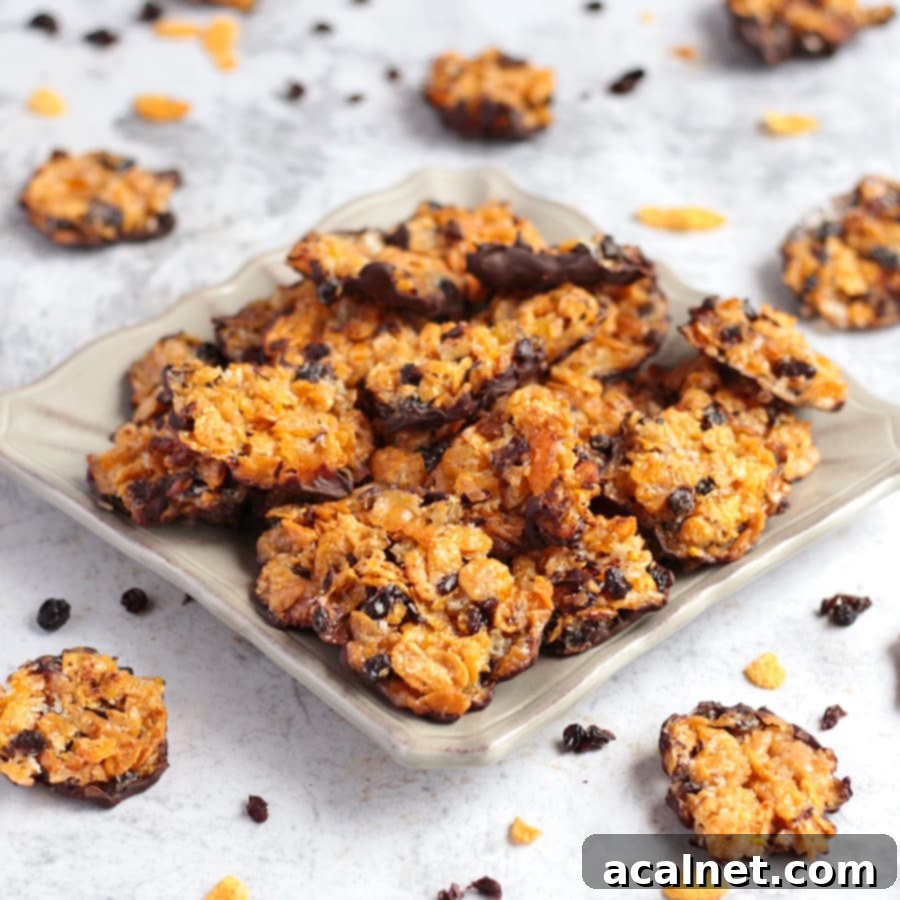Irresistible Nut-Free Florentine Cookies with Dark Chocolate: Your New Favorite Holiday Treat
These Easy Nut-Free Florentine Cookies, luxuriously dipped in rich Dark Chocolate, are the delightful sweet treat you never knew you needed in your life – but once you taste them, you won’t be able to live without them! Experience the perfect harmony of chewy and crunchy textures, with a delightful balance of sweet and bitter notes. They are truly the best little sweet indulgence for Christmas and the entire Holiday season, and honestly, they’re just as spectacular all year round!
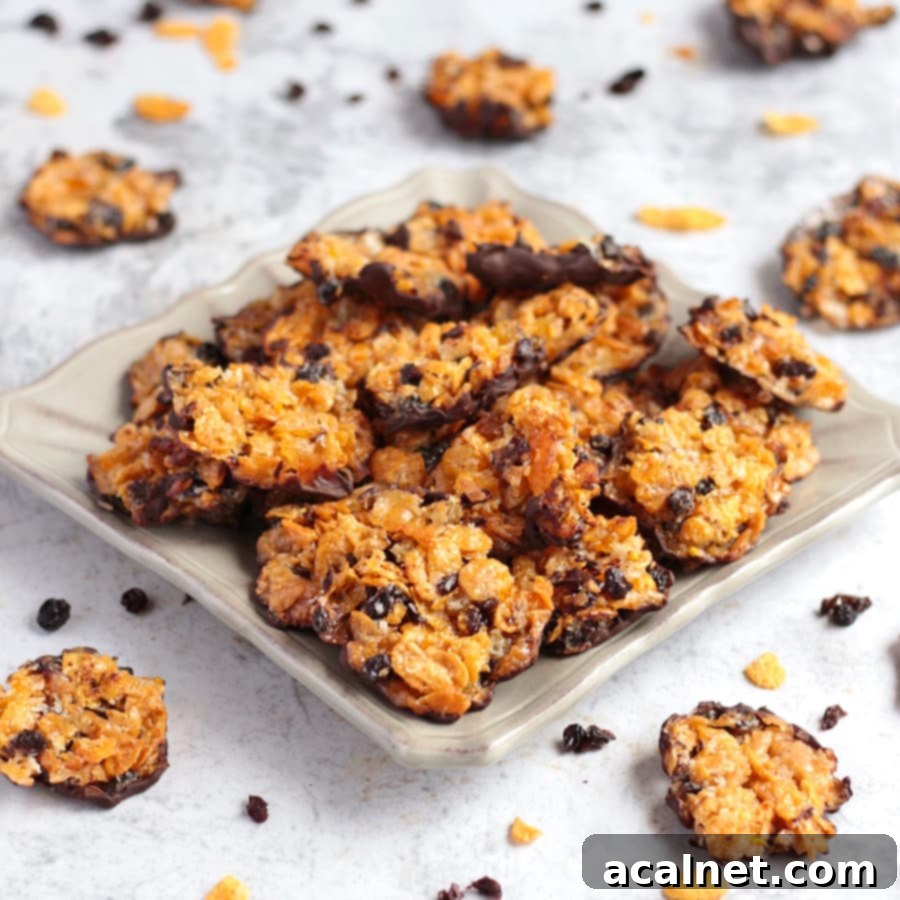
[feast_advanced_jump_to]
I have a confession to make: before a friend asked me to bake some Florentine biscuits, I had never even tasted them. And now, I can officially say my world has been rocked! These delectable cookies quickly soared to the top of my favorite sweet treats list, and I’m confident they’ll do the same for you.
This Florentine Cookies Recipe is not only incredibly easy to whip up, but it’s also a fantastic **Nut-Free Cookie** option. For those with nut allergies or simply looking for an alternative, this recipe offers all the classic Florentine charm without the common almond base. Just like my popular Biscoff Truffles and French Chocolate Truffles, these Florentine cookies are absolutely perfect for holiday gatherings, cookie exchanges, or any time you’re craving a blissful sweet fix!
What Exactly Are Florentine Cookies?
Florentine Biscuits are exquisite sweet confections traditionally characterized by a delicate blend of candied fruits, nuts, and a rich caramel binding, often finished with a smooth chocolate-coated base. Their name, ‘Florentine,’ immediately conjures images of Florence, Italy, suggesting a clear Italian origin. However, the true history of these beloved cookies is a delightful culinary debate.
While commonly attributed to Italy, many food historians argue that Florentines might actually have French roots. This contention arises because the specific combination of ingredients often found in traditional Florentine recipes – like certain candied fruits and caramel preparations – aren’t always typical of traditional Italian baking. Regardless of their precise birthplace, these cookies have charmed palates worldwide for centuries, evolving into various forms and interpretations across different cultures.
Sometimes, Florentines are called ‘Lace Cookies’ when they are made exceptionally thin, flat, and crispy, resembling delicate edible lace. However, the version I’m sharing with you today is more akin to the popular Florentine biscuits found in Australia: a thicker, wonderfully chewy cookie, distinctively made with crunchy Cornflakes. This unique twist provides an incredible texture that sets them apart from the thinner, more brittle varieties.
Intrigued by their history? You can delve deeper into the fascinating origins of Florentines by reading this super interesting article from Honest Cooking.
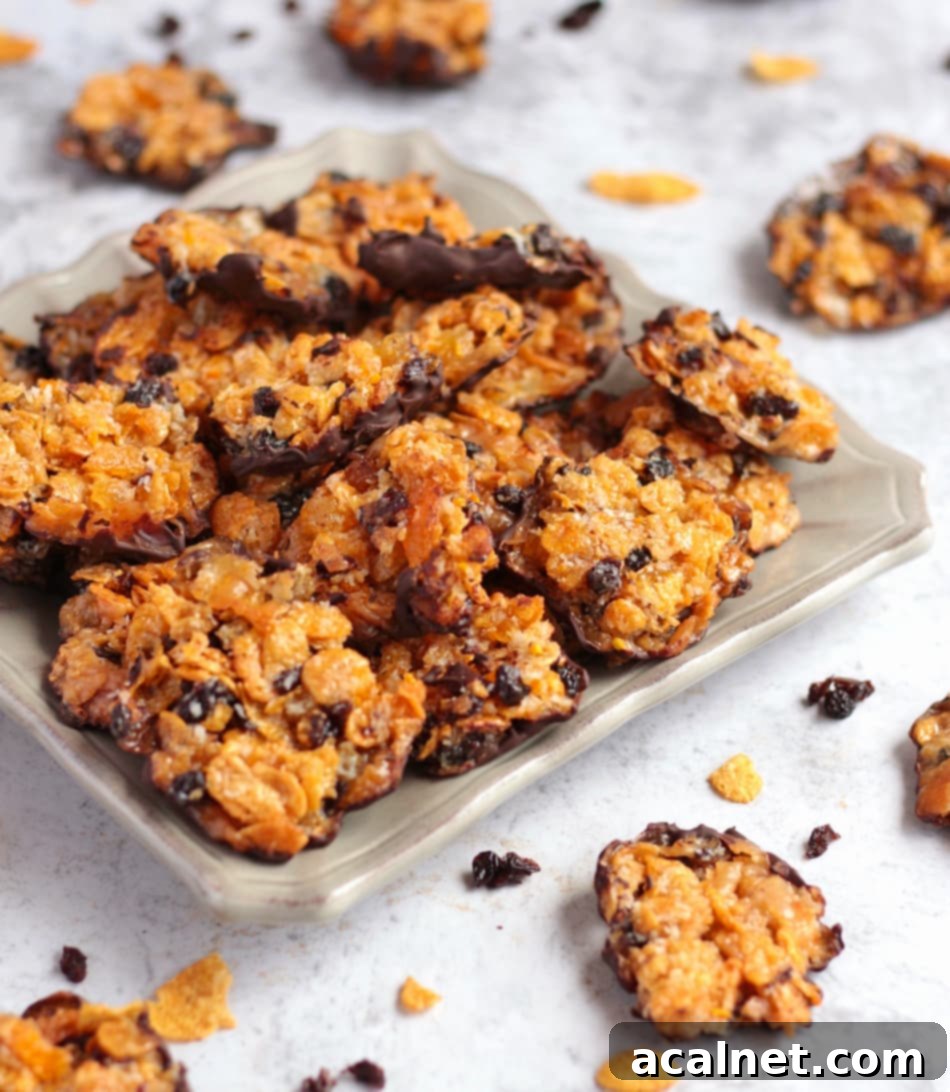
What are Florentines Typically Made Of? Understanding the Core Components
Defining the exact ingredients for Florentines can be surprisingly tricky! A quick online search will yield countless recipes, almost all featuring slightly different components. This diversity is part of their charm, but it can also be confusing. You might wonder: should they include Cornflakes or not? Are chopped Almonds or Almond Meal preferred? What about various Dried Fruits? And in the caramel, is it condensed milk, honey, cream, or butter that creates the perfect binder?
While the precise original ingredients remain elusive and vary by region and baker, we can broadly categorize the essential elements of any Florentine cookie into three main groups:
- The “Dry Ingredients” Mix: This forms the bulk and texture of the cookie, typically including dried fruits, nuts (or a nut-free alternative like cornflakes), and sometimes coconut.
- The Caramel Binder: This sweet, sticky mixture is crucial for holding all the dry ingredients together, giving the cookie its characteristic chewiness and rich flavor.
- The Chocolate Layer: Often, a bottom coating of chocolate provides a luxurious finish, adding a contrasting flavor and delightful snap.
In this particular recipe, we embrace a unique and delicious interpretation that prioritizes a **nut-free experience** while delivering exceptional taste and texture. Our version offers a thick, chewy biscuit packed with delightful crunch, making it an accessible treat for everyone to enjoy.
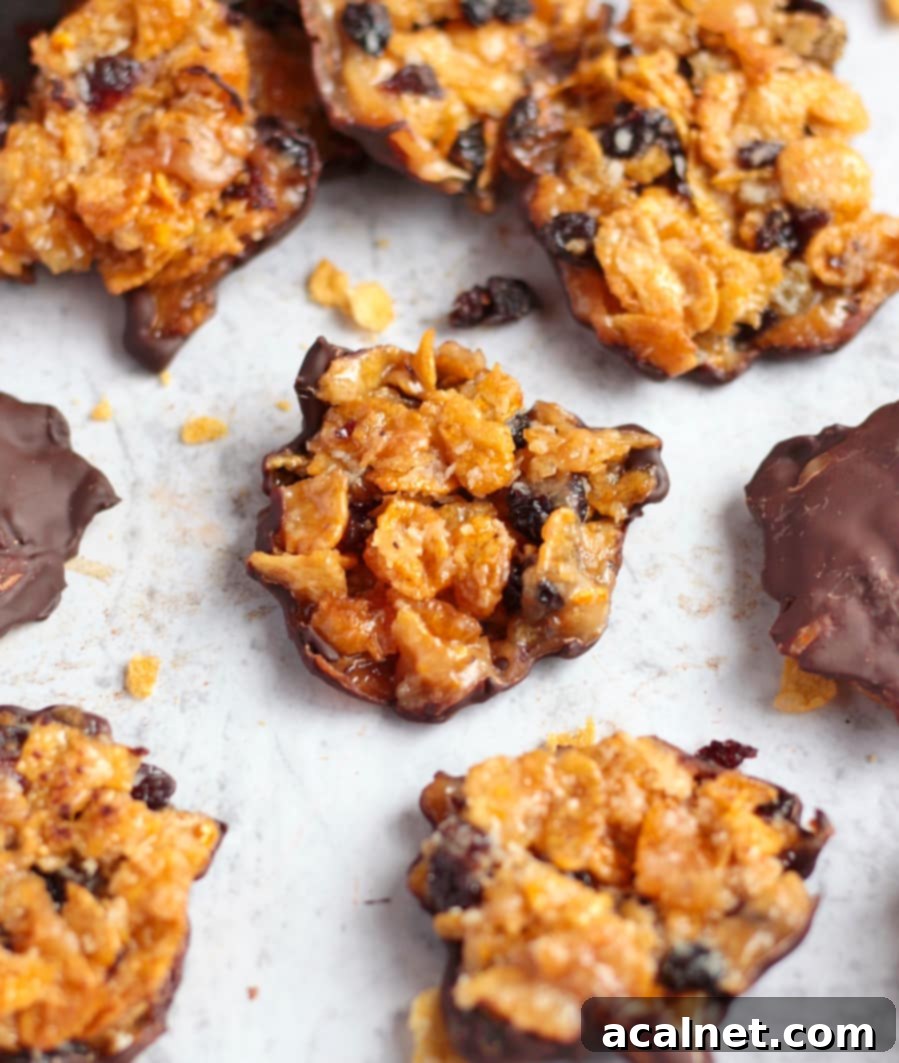
The Key Ingredients for These Delicious Nut-Free Florentine Cookies
My recipe for these delightful **Florentine Biscuits** stands out because it primarily uses **Cornflakes** to achieve that irresistible chewy yet crispy texture. And in what might be seen as a slightly unconventional but very welcome twist, they are made with absolutely **no nuts**! This makes them perfect for those with nut allergies or anyone looking to avoid nuts without sacrificing flavor or texture.
Incorporating **Cornflakes** into baked goods is one of my favorite baking secrets. They consistently deliver a fantastic crunch that complements almost any other ingredient. I particularly adore the combination of Cornflakes and Chocolate, which you can also find in my popular Chocolate Cornflake Cakes and Chocolate Peanut Butter Balls (though do note the peanut butter balls contain nuts if you are avoiding them!). The flakes provide a wonderful, airy crispness that elevates the entire cookie experience.
Beyond the Cornflakes, these treats are generously packed with a vibrant mix of **Dried Candied Fruits**, a touch of fragrant **Desiccated Coconut**, and finely chopped **Orange Peels**. This combination ensures a burst of fruity flavor and a pleasant chewiness that beautifully contrasts with the cornflake crunch.
When it comes to the crucial caramel binder, this Florentine recipe opts for a luscious blend of **Honey**, rich **Thickened Cream** (also known as Heavy Cream), and fine **Caster Sugar**. You won’t find condensed milk or butter in this caramel, which can sometimes make cookies feel greasy. Instead, our chosen ingredients create a smooth, glossy caramel that perfectly binds the mixture without any unwanted oiliness, ensuring a clean and delightful texture.
To embark on your Florentine cookie journey, here’s a comprehensive list of what you will need (please scroll down to the recipe card for precise quantities):
- Cornflakes: The star ingredient for crunch and texture.
- Dried Apricots: For a sweet, tangy chewiness.
- Raisins: Adding natural sweetness and a classic dried fruit flavor.
- Dried Currants: Small bursts of concentrated fruity taste.
- Desiccated Coconut: For a hint of tropical flavor and added texture.
- Orange Peels: Providing a wonderful citrus zest that brightens the whole cookie.
- Plain Flour: A small amount to help bind the dry ingredients and ensure stability.
- Thickened Cream (Heavy Cream): Essential for a rich, smooth caramel.
- Honey: Contributes a deep, floral sweetness to the caramel.
- Caster Sugar: To create the perfect caramel consistency and sweetness.
- Dark Chocolate: For dipping, offering a crucial bitter contrast.
I genuinely believe that using **Dark Chocolate** is absolutely critical to achieving the best flavor balance in these cookies. The cookie base itself is inherently sweet, thanks to the natural sugars in the dried fruits and the sweet honey caramel. Introducing the pleasing bitterness of **Dark Chocolate** (I highly recommend a 70% Dark Cooking Chocolate) creates a sophisticated contrast that prevents the cookie from being overly sweet, resulting in a perfectly harmonious and irresistible treat. It’s a match made in heaven!
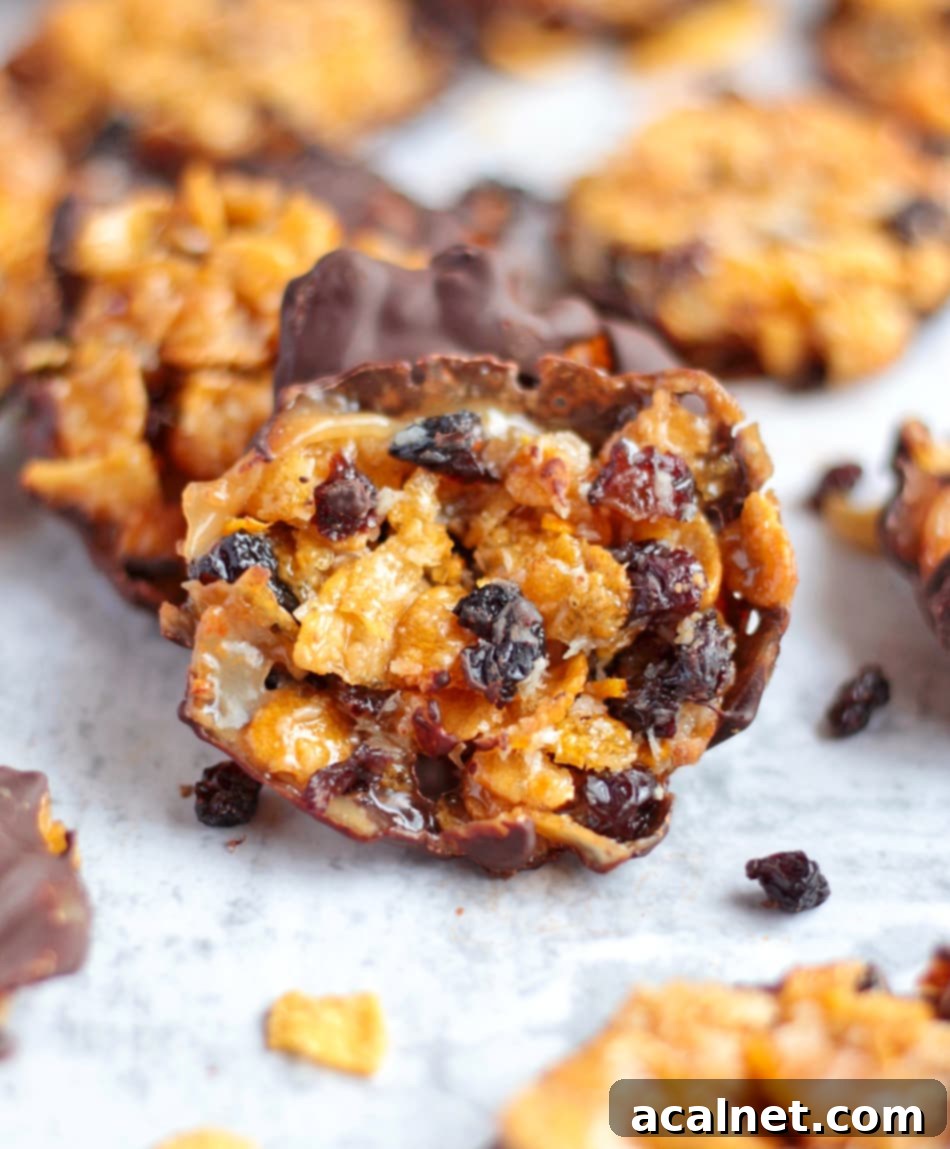
How to Make These Delicious Nut-Free Cornflake Florentine Cookies
Crafting these delectable Florentine cookies is a straightforward process, broken down into a few manageable steps that lead to a truly rewarding result. Before your Florentines even hit the oven, you’ll prepare the vibrant base and the luscious caramel. This can be summarized in four key preparation stages:
- Prepare the Dry Mix: Begin by thinly chopping your chosen dried fruits – the apricots, raisins, and currants. Precision in chopping helps ensure an even distribution of flavor and texture throughout each cookie. Once chopped, combine all the “Dry Mix” ingredients (dried fruits, cornflakes, desiccated coconut, orange peels, and a touch of flour) in a large, heat-proof mixing bowl. Mix them thoroughly to ensure everything is well combined and ready to absorb the caramel.
- Craft the Honey Caramel: Next, prepare the irresistible caramel binder. In a small saucepan, combine the Thickened Cream, Caster Sugar, and Honey. Place the pot over low heat, stirring continuously until the Caster Sugar has completely dissolved and the mixture becomes smooth, glossy, and fluid. It’s important to note that the caramel doesn’t need to boil or deepen in color at this stage; it will continue to cook and achieve its perfect hue in the oven.
- Combine Dry Mix and Caramel: This is where the magic starts to happen! Very carefully pour the warm, liquid caramel over your prepared “Dry Mix” in the heat-proof bowl. Using a sturdy spatula, stir the mixture really well. The goal is to ensure that all the dry ingredients are evenly coated in the sticky, sweet caramel. This step is crucial for the cookies to hold together and develop their signature chewy texture.
- Shape the Cookies: Now for shaping! Line a flat baking tray (you might need two or three, depending on the size) with baking paper. Scoop small, even drops of the Florentine batter onto the lined tray. Remember to leave ample space between each cookie, as they will spread a bit during baking. Use your fingers or the back of a spoon to gently flatten each mound into a regular, round shape. Pressing them down slightly helps them become compact and achieve that perfect Florentine look.
With your Florentine cookies prepped and shaped, it’s time to bake them to golden perfection and finish with a luxurious chocolate dip:
- Bake to Golden Perfection: Preheat your oven to 160°C / 320°F. Once it reaches temperature, carefully place the baking tray into the oven. Bake for approximately **7 minutes**. Keep a close eye on them; your Florentines should turn a beautiful golden color and spread slightly.
- Cool and Re-shape (if needed): Once baked, carefully remove the tray from the oven. Let the Florentines rest on the warm tray for about a minute to slightly firm up. Then, gently slide the baking paper sheet with the cookies onto a cooling rack. While they are still warm (be very careful, they will be hot!), you can use the back of a spoon to gently re-shape any cookies that might have spread unevenly. This helps achieve perfectly round biscuits. Allow them to cool down completely on the rack. This step is vital for them to set properly and become firm enough to handle.
- Check for Coolness: When the cookies are completely cool, they should be firm and easy to pick up without falling apart. Patience here will pay off!
- Melt the Dark Chocolate: Finely chop your chosen Dark Cooking Chocolate. Set up a double-boiler (or bain-marie) by placing a heat-proof bowl over a saucepan of simmering water, ensuring the bowl does not touch the water. Melt the chocolate slowly, stirring occasionally, until it is smooth and shiny. Alternatively, you can melt the chocolate carefully in the microwave (see notes for tips).
- Dip in Dark Chocolate: Take each cooled Florentine cookie and dip its flat bottom side into the melted dark chocolate. Gently scrape any excess chocolate against the top edge of the bowl to create a neat coating.
- Set the Chocolate: Place the chocolate-dipped cookies back onto the cooling rack, chocolate side facing up. Allow the chocolate to set and dry completely at room temperature. This will give you a firm, glossy chocolate base.
Once the chocolate has fully set, your irresistible Nut-Free Florentine Cookies are ready to be enjoyed or stored for later indulgence!
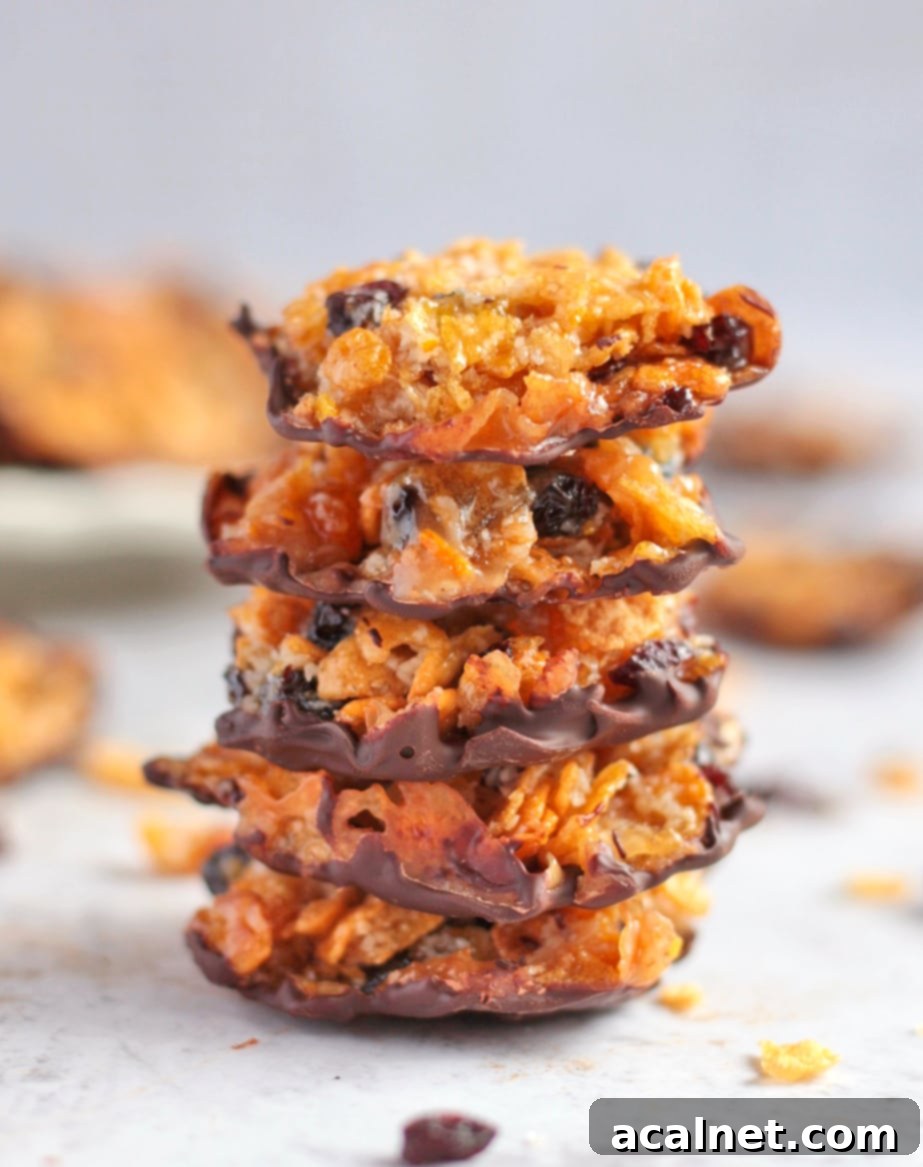
Florentine Cookie Recipe FAQs
While this particular Florentine recipe, as written, is not Gluten-Free because it contains Wheat Flour, it can very easily be adapted! To make it gluten-free, simply substitute the plain Wheat Flour with a suitable Gluten-Free all-purpose flour blend or a starch like Cornstarch. It’s also absolutely crucial to ensure you are using certified Gluten-Free Cornflakes, as some brands may contain gluten or be processed in facilities that handle gluten-containing grains. Always check the packaging carefully to guarantee a truly gluten-free result.
Once the delicious dark chocolate layer has fully cooled and completely set, it’s time to properly store your Florentine cookies. Transfer them into an air-tight container to maintain their freshness and protect them from moisture. To prevent them from sticking together, especially if stacking multiple layers, place a piece of baking paper or parchment paper between each layer of cookies. These cookies are best kept at room temperature in a cool, dark, and shady spot, such as your pantry. Stored correctly, they can surprisingly last for weeks, if not months – literally! However, like most baked goods, they are always best enjoyed as fresh as possible, ideally within the first week or two for peak texture and flavor.
It might be tempting to store your Florentines in the refrigerator, especially if your kitchen is warm, to prevent the chocolate from melting. However, I strongly advise against this. Refrigeration will cause the Florentine biscuits to lose their wonderful crispiness and become almost soggy, compromising their signature chewy-crunchy texture. Stick to a cool, dry pantry for the best results.
I **do not recommend** freezing these Florentine cookies. Freezing introduces moisture, which is the enemy of crispy, chewy Florentines. When thawed, the cookies tend to lose their delicate texture, becoming overly soft and often falling apart. Furthermore, proper storage at room temperature allows these Florentine cookies to last for months, eliminating the need for freezing. Enjoy them fresh, and store them in an airtight container in your pantry for lasting deliciousness.
Absolutely! While apricots, raisins, and currants offer a fantastic flavor profile, feel free to experiment with your favorite dried fruits. Chopped dried cranberries, cherries, or even finely diced pineapple can add interesting twists. Just ensure they are chopped to a similar size for even distribution and baking.
If your caramel mixture starts to harden before you’ve fully coated all the dry ingredients, you can gently warm it again over very low heat on the stove, stirring continuously until it becomes fluid once more. Be careful not to overheat it, just enough to make it workable. Work quickly when combining it with the dry ingredients to prevent it from setting.

More Delicious Cookie Recipes to Explore:
- Sable Breton Cookies (French Salted Butter Cookies)
- Almond Tahini Cookies
- Chocolate and Vanilla Marble Cookies
- 3 Ingredients Almond Cookies
- Lemon and Poppy Seed Shortbread Cookies
- Almond Flour Peanut Butter Cookies
- Almond Shortbread Cookies
- Oatmeal Peanut Butter Banana Cookies
- Chocolate Hazelnut Shortbread Cookies
Made this recipe?
Let us know if you liked it by leaving a comment below, and tag us on Instagram @a.baking.journey with a photo of your delightful creation!
Recipe

Nut-Free Florentine Cookies
Print Recipe
Ingredients
- 75 gr (3 cups) Cornflakes, slightly crushed
- 30 gr (1/3 cup) Desiccated Coconut
- 30 gr (2 1/2 tbsp) Dried Apricots, thinly chopped
- 30 gr (1/4 cup) Raisins, thinly chopped
- 30 gr (1/4 cup) Dried Currants, thinly chopped
- 1/3 Orange Peels, (the peels of about 1/3 of an orange)
- 10 gr (1 tbsp) Plain Flour
- 85 gr (1/3 cup + 1 tbsp) Caster Sugar
- 45 gr (3 tbsp) Thickened Cream
- 45 gr (2 tbsp) Honey
- 100 gr (4 oz) Dark Cooking Chocolate, 70% Dark Chocolate recommended
Instructions
- Thinly Chop the Dried Apricots, Currants and Raisins. Place in a large heat-proof mixing bowl.
- Peel about one third of an orange and chop the peels very thinly. Add the the dried fruits.
- Add the Cornflakes (see note 1), Desiccated Coconut and Flour. Stir well.
- Place the Cream, Caster Sugar and Honey in a small Pot. Place on a low-heat stove, stiring occasionally until smooth, glossy and liquid. The Caster Sugar should have completely disolved (see note 2).
- Very carefully pour the Caramel Sauce over the Dry Mix (it will be very hot), and use a stiff spatula to mix it all together (see note 3). Keep stiring until all the dry ingredients seem to be evenly coated in caramel.
- Preheat your oven on 160’C/320’F. Line a Flat Baking Tray (you will probably need 2 or 3) with baking paper.
- Scoop out a little bit of the Florentine Batter and drop it on the lined Tray. Gently flatten it out into a regular round shape with your fingers or the back of a spoon. Leave space between each cookie as they will spread in the oven.
- Bake for about 7 minutes or until they look golden brown (see note 4).
- Take the tray out of the oven and set aside for about 1 minutes, then carefully slide the baking paper with the cookies onto a cooling rack. If need, adjust the shape of the cookies with the back of a spoon while they are still warm, then leave to cool completely.
- Thinly chop the Chocolate and place in a heat-proof bowl. Melt the Chocolate using a Double-Boiler (“bain-marie”) until smooth and shiny. (see note 5)
- Dip the cool cookie flat bottom side into the chocolate, removing any excess by rubbing it against the top edges of the bowl. Place back on the cooling rack, chocolate side up, and leave to set and dry completely.
- When cool, transfer into an air-tight container, separating each level of cookies with baking paper to avoid sticking to each other. Keep at room temperature in a cool, shady spot.
Would you like to save this recipe?
We’ll email this post to you, so you can come back to it later!
Notes
- I find that crushing the Cornflakes slightly helps to create even-looking florentines with a more uniform texture. However, if you prefer larger, more prominent flakes, this step is not essential.
- When preparing the caramel, you can remove it from the heat once the sugar has completely dissolved and you begin to see small bubbles forming around the edges of the pot. The caramel does not need to come to a full boil or thicken at this stage, as it will continue to cook and set beautifully in the oven.
- For optimal distribution of the caramel, I find it easiest to pour the sauce over the dry mix in two stages, thoroughly mixing the ingredients after each addition. This ensures every cornflake and dried fruit piece is perfectly coated.
- It’s crucial to keep a watchful eye on your cookies while they bake, as oven temperatures can vary significantly. You’re looking for a lovely golden brown color, indicating they are cooked through and crispy, but be very careful to avoid burning them.
- If you choose to melt your dark chocolate in the microwave, proceed with caution to prevent burning. Heat the chocolate in short bursts, stopping every 15-30 seconds to stir. Continue this process until almost all the chocolate has melted, but a few small chunks still remain. Remove it from the microwave and continue stirring until the residual heat melts the remaining chocolate into a smooth, glossy consistency.
Nutrition (per serving)
